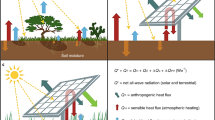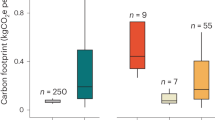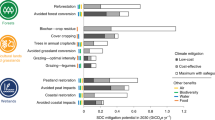Abstract
Terrestrial controlled environment agriculture (CEA) will have an increasingly important role in food production. However, present CEA systems are energy- and resource-hungry and rarely profitable, requiring a step change in design and optimization. Here we argue that the unique nature of space controlled environment agriculture (SpaCEA), which needs to be both highly resource efficient and circular in design, presents an opportunity to develop intrinsically circular CEA systems. Life-cycle analysis tools should be used to optimize the provision and use of natural or electrical light, power, nutrients and infrastructure in CEA and/or SpaCEA systems, and to guide research and development into subsystems that bring strong environmental advantages. We suggest that SpaCEA public outreach can also be used to improve the perception of terrestrial CEA on Earth by using space as a gateway for exhibiting CEA food growing technologies. A substantial focus on SpaCEA development should be viewed as an efficient contribution to addressing major current CEA challenges.
This is a preview of subscription content, access via your institution
Access options
Access Nature and 54 other Nature Portfolio journals
Get Nature+, our best-value online-access subscription
$29.99 / 30 days
cancel any time
Subscribe to this journal
Receive 12 digital issues and online access to articles
$119.00 per year
only $9.92 per issue
Buy this article
- Purchase on Springer Link
- Instant access to full article PDF
Prices may be subject to local taxes which are calculated during checkout

Similar content being viewed by others
References
NASA’s Lunar Exploration Program Overview (NASA, 2020); https://www.nasa.gov/sites/default/files/atoms/files/artemis_plan-20200921.pdf
Douglas, G. L., Wheeler, R. M. & Fritsche, R. F. Sustaining astronauts: resource limitations, technology needs, and parallels between spaceflight food systems and those on earth. Sustainability 13, 9424 (2021).
Monje, O. et al. New frontiers in food production beyond LEO. In 49th Int. Conference on Environmental Systems (ICES, 2019).
Poulet, L. et al. Crew time in a space greenhouse using data from analog missions and Veggie. Life Sci. Space Res. 31, 101–112 (2021).
Sercel, J. C. et al. in Primitive Meteorites and Asteroids 477–524 (Elsevier, 2018).
Kalmbach, J. A. & Ralston, J. J. Sights on Mars: continuity and change in support for space policy. Space Policy 57, 101446 (2021).
Platt, C. A., Jason, M. & Sullivan, C. J. Public perceptions of private space initiatives: how young adults view the SpaceX plan to colonize mars. Space Policy 51, 101358 (2020).
Steinberg, A. Space policy responsiveness: the relationship between public opinion and NASA funding. Space Policy 27, 240–246 (2011).
Hewett, E. W. & Warrington, I. J. Creation of harvesting the sun: a profile of world horticulture. Acta Hortic. 1051, 15–22 (2014).
Asseng, S. et al. Wheat yield potential in controlled-environment vertical farms. Proc. Natl Acad. Sci. USA https://doi.org/10.1073/pnas.2002655117 (2020).
Orsini, F., Pennisi, G., Zulfiqar, F. & Gianquinto, G. Sustainable use of resources in plant factories with artificial lighting (PFALs). Eur. J. Hortic. Sci. 85, 297–309 (2020).
van Delden, S. H. et al. Current status and future challenges in implementing and upscaling vertical farming systems. Nat. Food 2, 944–956 (2021).
Sandison, F., Yeluripati, J. & Stewart, D. Does green vertical farming offer a sustainable alternative to conventional methods of production? A case study from Scotland. Food Energy Secur. https://doi.org/10.1002/fes3.438 (2022).
Bamsey, M. et al. Developing strategies for automated remote plant production systems: environmental control and monitoring of the Arthur Clarke Mars Greenhouse in the Canadian High Arctic. Adv. Sp. Res. 44, 1367–1381 (2016).
Tachikawa, S., Nagano, H., Ohnishi, A. & Nagasaka, Y. Advanced passive thermal control materials and devices for spacecraft: a review. Int. J. Thermophys. 43, 91 (2022).
Miyakita, T., Hatakenaka, R., Sugita, H., Saitoh, M. & Hirai, T. Development of a new multi-layer insulation blanket with non-interlayer-contact spacer for space cryogenic mission. Cryogenics 64, 112–120 (2014).
Dye, S., Kopelove, A. & Mills, G. L. Novel load responsive multilayer insulation with high in-atmosphere and on-orbit thermal performance. Cryogenics 52, 243–247 (2012).
Torres Pineda, I., Lee, Y. D., Kim, Y. S., Lee, S. M. & Park, K. S. Review of inventory data in life cycle assessment applied in production of fresh tomato in greenhouse. J. Clean. Prod. 282, 124395 (2021).
Kikuchi, Y., Kanematsu, Y., Yoshikawa, N., Okubo, T. & Takagaki, M. Environmental and resource use analysis of plant factories with energy technology options: a case study in Japan. J. Clean. Prod. 186, 703–717 (2018).
Torrellas, M. et al. LCA of a tomato crop in a multi-tunnel greenhouse in Almeria. Int. J. Life Cycle Assess. 17, 863–875 (2012).
Avgoustaki, D. D. & Xydis, G. Indoor vertical farming in the urban nexus context: business growth and resource savings. Sustainability 12, 1965 (2020).
Valle de Souza, S., Peterson, H. C. & Seong, J. in Plant Factory Basics, Applications and Advances Vol. 4, 251–270 (Elsevier, 2022).
Net Cash Farm Income of the Operations and Producers: 2017 and 2012 (USDA, 2018); https://www.nass.usda.gov/Publications/AgCensus/2017/Full_Report/Volume_1,_Chapter_1_US/st99_1_0005_0006.pdf
Farm Business Income by Type of Farm in England 2021/22 (UK Government, 2022); https://www.gov.uk/government/statistics/farm-business-income/farm-business-income-by-type-of-farm-in-england-202122
Perambalam, L. et al. How young consumers perceive vertical farming in the Nordics. Is the market ready for the coming boom? Agronomy 11, 2128 (2021).
Specht, K. et al. How will we eat and produce in the cities of the future? From edible insects to vertical farming: a study on the perception and acceptability of new approaches. Sustainability 11, 4315 (2019).
Jürkenbeck, K., Heumann, A. & Spiller, A. Sustainability matters: consumer acceptance of different vertical farming systems. Sustainability 11, 4052 (2019).
Ryan, S. F. et al. The role of citizen science in addressing grand challenges in food and agriculture research. Proc. R. Soc. B 285, 20181977 (2018).
Raymond, C., Litzinger, M., Wen, Y., Padolf, A. & Lewis, C. Growing Beyond Earth Evaluation Results Summary: 2016–2020 (Reimagining Equity and Values in Informal STEM Education, 2020); https://www.informalscience.org/growing-beyond-earth-evaluation-results-summary-2016-2020
Anderson, M. S. et al. Key gaps for enabling plant growth in future missions. AIAA Space and Astronautics Forum Exposition 2017 https://doi.org/10.2514/6.2017-5142 (AIAA, 2017).
Alexander, C., Fritsche, R. F. & Massa, G. D. Gaps List KSC Space Crop Production Project Scientist: Interview Evaluation (NASA NTRS, 2021); https://ntrs.nasa.gov/citations/20210019414
SharathKumar, M., Heuvelink, E. & Marcelis, L. F. M. Vertical farming: moving from genetic to environmental modification. Trends Plant Sci. 25, 724–727 (2020).
Lee, S. & Lee, J. Beneficial bacteria and fungi in hydroponic systems: types and characteristics of hydroponic food production methods. Sci. Hortic. 195, 206–215 (2015).
French, E., Kaplan, I., Iyer-Pascuzzi, A., Nakatsu, C. H. & Enders, L. Emerging strategies for precision microbiome management in diverse agroecosystems. Nat. Plants 7, 256–267 (2021).
Khodadad, C. L. M. et al. Microbiological and nutritional analysis of lettuce crops grown on the International Space Station. Front. Plant Sci. 11, 206–215 (2020).
Hendrickx, L. et al. Microbial ecology of the closed artificial ecosystem MELiSSA (Micro-Ecological Life Support System Alternative): reinventing and compartmentalizing the Earth’s food and oxygen regeneration system for long-haul space exploration missions. Res. Microbiol. 157, 77–86 (2006).
Berliner, A. J. et al. Space bioprocess engineering on the horizon. Commun. Eng. 1, 13 (2022).
Chen, D. et al. Prospects of improving efficiency of fertiliser nitrogen in Australian agriculture: a review of enhanced efficiency fertilisers. Aust. J. Soil Res. 46, 289–301 (2008).
Cowan, N. et al. CEA systems: the means to achieve future food security and environmental sustainability? Front. Sustain. Food Syst. 6, 891256 (2022).
Anand, M. et al. A brief review of chemical and mineralogical resources on the Moon and likely initial in situ resource utilization (ISRU) applications. Planet. Space Sci. 74, 42–48 (2012).
Volger, R. et al. Mining moon & mars with microbes: biological approaches to extract iron from Lunar and Martian regolith. Planet. Space Sci. 184, 104850 (2020).
Roberts, A. D. et al. Blood, sweat, and tears: extraterrestrial regolith biocomposites with in vivo binders. Mater. Today Bio 12, 100136 (2021).
Menezes, A. A., Cumbers, J., Hogan, J. A. & Arkin, A. P. Towards synthetic biological approaches to resource utilization on space missions. J. R. Soc. Interf. 12, 20140715 (2015).
Pilehvar, S., Arnhof, M., Pamies, R., Valentini, L. & Kjøniksen, A. L. Utilization of urea as an accessible superplasticizer on the moon for lunar geopolymer mixtures. J. Clean. Prod. 247, 119177 (2020).
Hetherington, A. C., Borrion, A. L., Griffiths, O. G. & McManus, M. C. Use of LCA as a development tool within early research: challenges and issues across different sectors. Int. J. Life Cycle Assess. 19, 130–143 (2014).
ISO 14040 Environmental Management — Life Cycle Assessment — Principles and Framework (ISO, 2006); https://www.iso.org/standard/37456.html
ISO 14044 Environmental Management — Life Cycle Assessment — Requirements and Guidelines (ISO, 2006); https://www.iso.org/standard/38498.html
Wilkinson, M. D. et al. The FAIR Guiding Principles for scientific data management and stewardship. Sci. Data 3, 160018 (2016).
ISO/TR 14062 Environmental Management — Integrating Environmental Aspects into Product Design and Development (ISO, 2002); https://www.iso.org/standard/33020.html
Maury, T., Loubet, P., Serrano, S. M., Gallice, A. & Sonnemann, G. Application of environmental life cycle assessment (LCA) within the space sector: a state of the art. Acta Astronaut. 170, 122–135 (2020).
Cucurachi, S., Scherer, L., Guinée, J. & Tukker, A. Life cycle assessment of food systems. One Earth 1, 292–297 (2019).
Horton, P. et al. An agenda for integrated system-wide interdisciplinary agri-food research. Food Secur. 9, 195–210 (2017).
Wheeler, R. M. Agriculture for space: people and places paving the way. Open Agric. 2, 14–32 (2017).
Vermeulen, A. C. J., Hubers, C., de Vries, L. & Brazier, F. What horticulture and space exploration can learn from each other: the Mission to Mars initiative in the Netherlands. Acta Astronaut. 177, 421–424 (2020).
Acknowledgements
We thank the Institute of Sustainable Food at the University of Sheffield for funding this work. We also thank K. Ostojic from RAL Space for inputs in the early discussions on this Perspective.
Author information
Authors and Affiliations
Corresponding author
Ethics declarations
Competing interests
The authors declare no competing interests.
Peer review
Peer review information
Nature Food thanks Andrew Beacham and the other, anonymous, reviewer(s) for their contribution to the peer review of this work.
Additional information
Publisher’s note Springer Nature remains neutral with regard to jurisdictional claims in published maps and institutional affiliations.
Rights and permissions
Springer Nature or its licensor (e.g. a society or other partner) holds exclusive rights to this article under a publishing agreement with the author(s) or other rightsholder(s); author self-archiving of the accepted manuscript version of this article is solely governed by the terms of such publishing agreement and applicable law.
About this article
Cite this article
Wright, H.C., Fountain, L., Moschopoulos, A. et al. Space controlled environment agriculture offers pathways to improve the sustainability of controlled environmental agriculture on Earth. Nat Food 4, 648–653 (2023). https://doi.org/10.1038/s43016-023-00819-5
Received:
Accepted:
Published:
Issue Date:
DOI: https://doi.org/10.1038/s43016-023-00819-5



